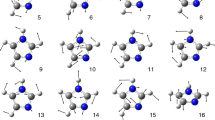Abstract
The potentiometric titration curves and computer modelling studies indicated that aluminium complexes with alanine at-C00− moiety and also altered the proton affinity at+NH3 and-CH3 moiety.27Al NMR spectra broadening also confirmed the interaction.
Similar content being viewed by others
References
Bjorksten JA: Aluminium as a cause of senile dementia. Comp Ther 8: 73–76, 1982
Crapper DR, Quittkat S, Krishnan SS, Dalton AJ, DeBoni U: Intranuclear aluminium content in Alzheimer's dialysis encephalopathy and experimental aluminium encephalopathy. Acta Neuropathol (Berl) 50: 19–24, 1980
King SW, Savory J, Wills MR: The clinical biochemistry of aluminium. CRC Crit Rev Clin Lab Sci 14: 1–20, 1981
Martin BR: The chemistry of aluminium as related to biology and medicine. Clin Chem 32: 1797–1806, 1986
Cowburn JD, Blair JA: Aluminium chelator (Transferrin) reverses biochemical deficiency. In: Alzheimer's brain preparations. Lancet, January 14: 99, 1989 (Vol. I for 1989)
Mazarguil H, Haran R, Laussac JP: The binding of aluminium to (Leu5)-enkephalin in an investigation using1H,13C and27Al NMR spectroscopy. Biochem Biophys Acta 717: 465–472, 1982
Bertholf RL, Wills MR, Savory J: Quantitative study of aluminium binding to human serum albumin and transferrin by a chelex competitive binding assay. Biochem Biophys Res Commun 125: 1020–24, 1984
Sigel H, Martin BR: Coordinating properties of the amide bond. Stability and structure of metal ion complexes of peptides and related ligands. Chem Rev 82: 385–426, 1982
Singh MK, Srivastava MN: Stepwise formation of beryllium (II) and aluminium (III) chelates with aspartic and glutamic acids. J Inorg Nucl Chem 34: 567–73, 1972
Jagannatha Rao KS: Aluminium complex with biocomponents. Proc Acad Environ Biol 1: 105–111, 1992
Deloncle R, Guillard O: Mechanism of Alzheimer's disease: Arguments for a Neurotransmitter-Aluminium complex implication. Neurochem Res 15: 1239–1245, 1990
Lehninger AL: Principles of Biochemistry, CBS Publishers and Distributors (India), 1984, pp 57–95
Rajan KS, Davis JM, Colburn RW: Metal chelates in the storage and transport of neurotransmitters: Interaction of Cu2+ with ATP and biogenic amines. J Neurochem 22: 137–147, 1974
Pauling L, Corey RB, Branson HR: The structure of proteins: Two hydrogen-bonded helical configurations of the polypeptide chain. Proc Natl Acad Sci (USA) 37: 205–211, 1951
Crabbe MJC, Appleyard JR: Desk Top Molecular Modeller Software Version 1.2: Oxford University Press, 1990
Author information
Authors and Affiliations
Rights and permissions
About this article
Cite this article
Jagannatha Rao, K.S., Rao, G.V. The characterization of aluminium — alanine complex. Mol Cell Biochem 137, 61–64 (1994). https://doi.org/10.1007/BF00926040
Received:
Accepted:
Issue Date:
DOI: https://doi.org/10.1007/BF00926040




